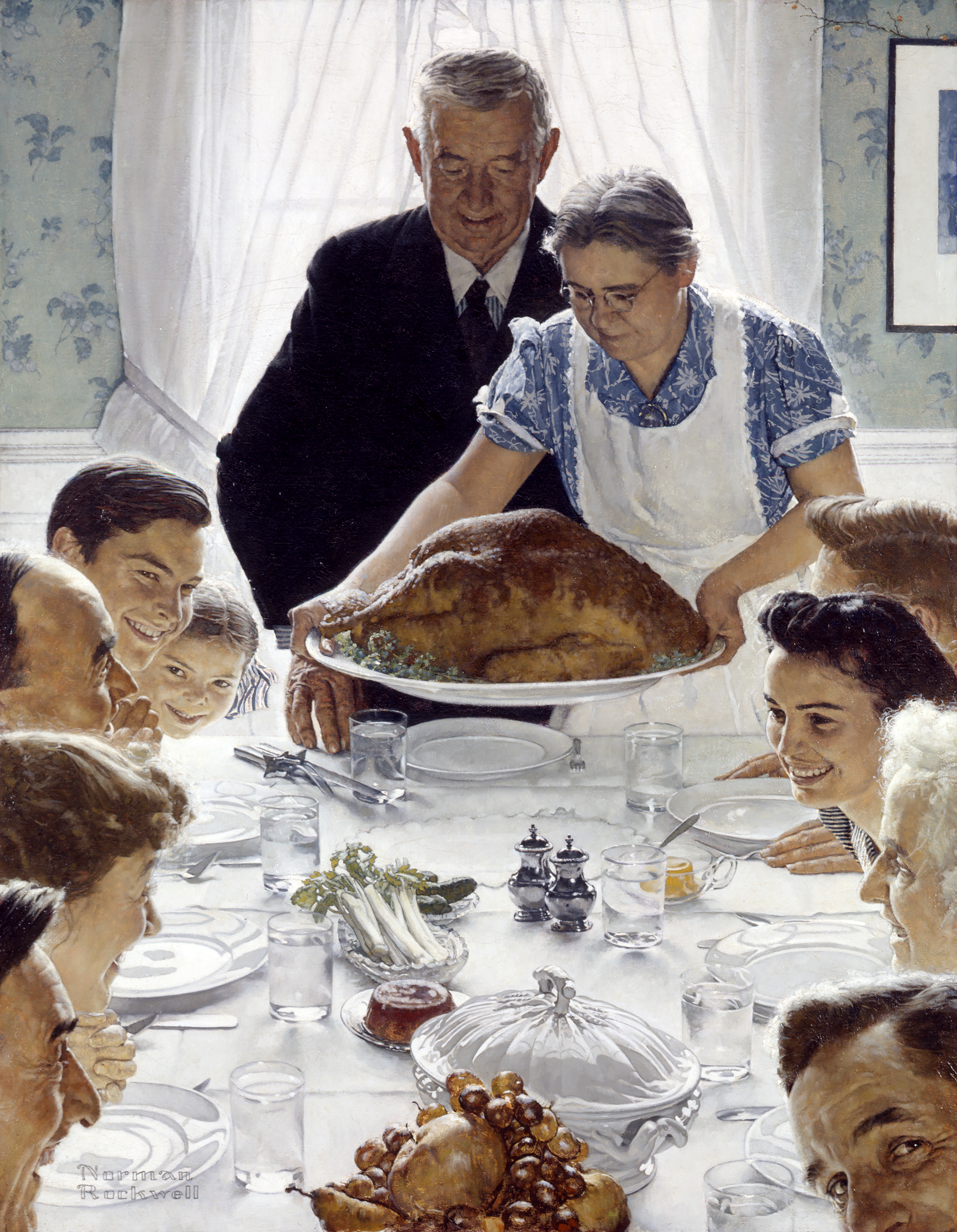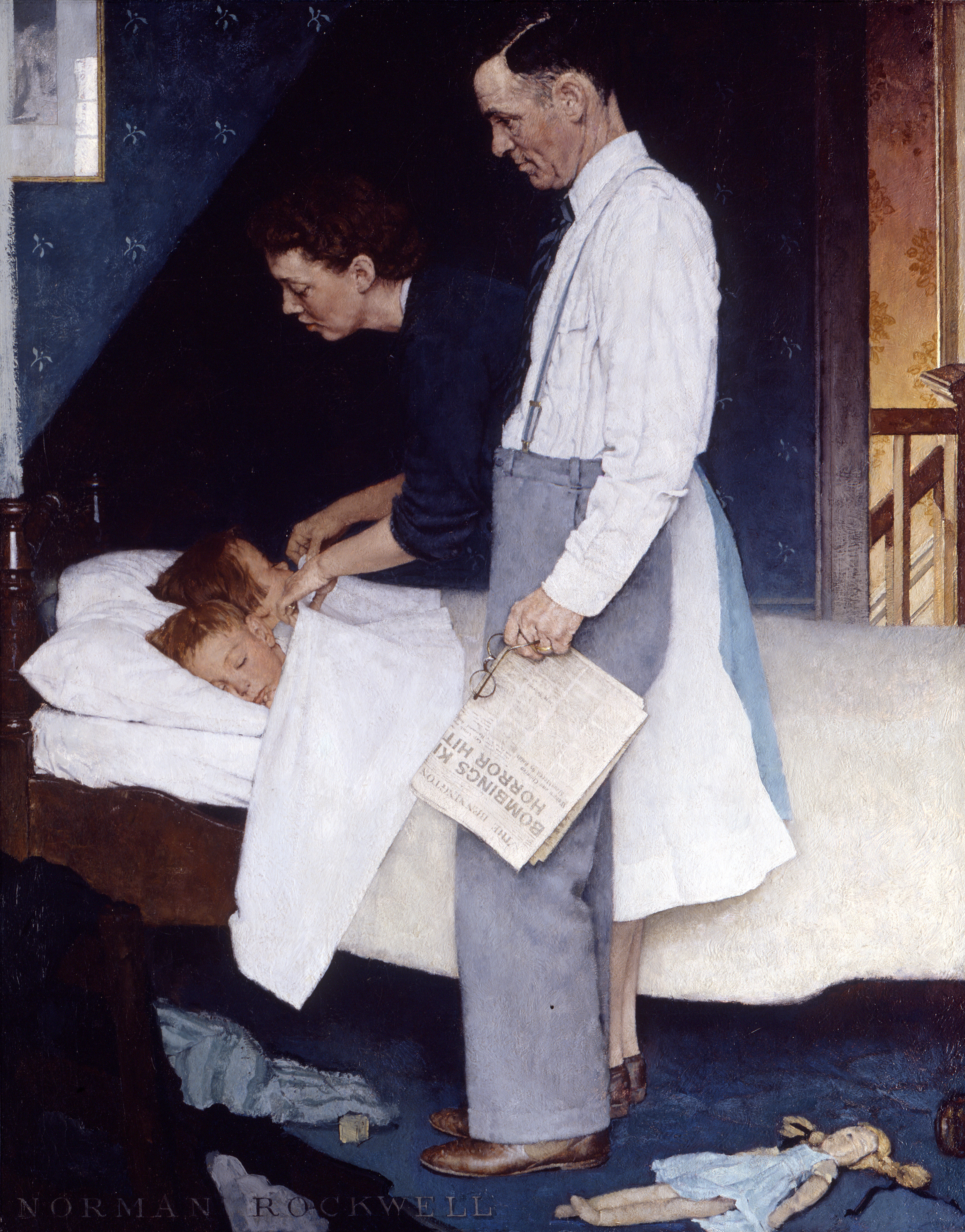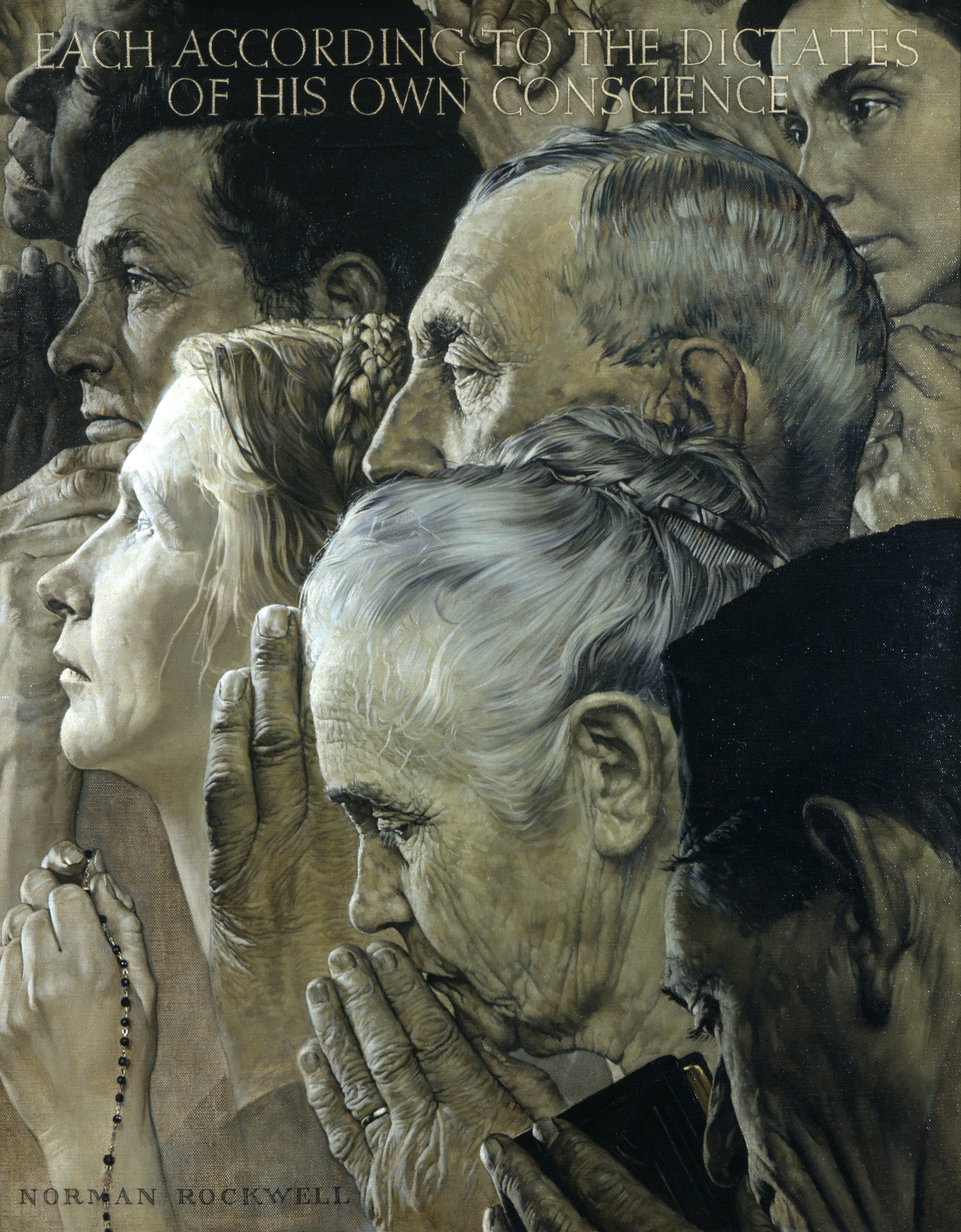Close Reading of the Four Freedom Illustration
Overview:
Students are introduced to the Four Freedoms which President Roosevelt identified in his January 6, 1941 annual address to Congress. Each of the freedoms is addressed individually. Through close reading of the illustrations by Norman Rockwell, students identify details contained in the paintings. They use these details to make and support inferences reflecting the meaning of the Four Freedoms in our everyday lives.
Enduring Understandings/ Essential Questions:
- The Four Freedoms are the rights of all citizens of the world.
- World War II was fought to protect these rights.
- President Roosevelt named the Four Freedoms as Freedom from Want, Freedom from Fear, Freedom of Worship, and Freedom of Speech.
- The Four Freedoms are reflected in our lives.
- What does “freedom” mean to you?
- How are the Four Freedoms reflected in your life?
- Are there other freedoms that everyone should have?
- Grade
- 3-5
- Theme
- Four Freedoms
- Length
- 4 periods, 40 minutes each
- Discipline
- Social Studies; Language Arts: Reading; Language Arts: Speaking and Listening
- Vocabulary
- Freedom; Worship; Want; Need; Speech
Objectives:
- Students will closely examine each of the Four Freedoms illustrations painted by Norman Rockwell.
- Students will make inferences related to the details and the freedom title.
- Students will reflect on the how the Four Freedoms relate to them.
- Students will participate in discussions focusing on the Four Freedoms.
Background:
World War II began in 1939. The United States was not involved in the beginning of the war, however, President Franklin D. Roosevelt believed that the United States would eventually need to play a role. In January 1941, he made his speech to Congress. In his speech, President Roosevelt named the Four Freedoms, which he stated are the rights of everyone in the world. After the speech, he and his administration questioned whether the citizens of the United States truly understood the Four Freedoms that he had named. He and the Office of War Information invited artists working in all media, authors, and designers to help illustrate and circulate thoughts on the Four Freedoms. Many artists created artwork in the form of paintings as well as sculptures to reflect the meaning of these freedoms. Norman Rockwell thought a lot about these ideals. In 1943, his completed his Four Freedoms illustrations, which were published in The Saturday Evening Post in four separate issues in February and March 1943; each was accompanied by a related essay. America entered World War II following the bombing of Pearl Harbor on December 7, 1941, and his illustrations helped Americans to envision the ideals that they were fighting for. They continue to represent the meaning of these freedoms today.
Materials:
Multimedia Resources
Freedom of Speech
Freedom from Want
Freedom from Fear
Freedom of Worship
Norman Rockwell's Four Freedoms
Norman Rockwell Museum
Franklin D. Roosevelt's Four Freedoms
Norman Rockwell Museum
Classroom Supplies:
- Chart paper with T-chart labeled “What I see (noticed)/ What I think (can infer)
- Marker
Activities:
Present each illustration separately. Allow 20 to 30 minutes for the reading and discussion of each. Freedom from Want is particularly accessible to most students and works well as a starting point.
- Display the illustration Freedom from Want.
- Give students a few minutes to observe the illustration in silence.
- Turn and Talk: When you feel enough time has passed, have students turn to a person sitting beside them. Ask them to share with each other some of the things they notice in the illustration. As they are sharing, listen in on some of the conversations.
- Identify a few students to share what they noticed. Record their observations on chart paper. (Elicit comments overheard during partner talk that are not shared.)
- Turn and Talk: When everyone has had the opportunity to share, have students turn to face their partners again. What details and observations can they add to their previous discussion?
- Have students share their thinking based on evidence from the illustration. Record responses on the T-chart.
- New observations may be contributed as they look closer and are thinking about the details. Add them to the appropriate column on T-Chart.
- Share the origin of the painting and its name. Give as much information as is appropriate for the maturity of the students. You may want to discuss the use of the word “want,” as many students may associate it with things they wish to have rather than “want of necessities,” such as food, water, shelter, and companionship. Share that there are four paintings in this collection. They will have opportunity to look at the others over in subsequent lessons.
Before sharing another illustration, you may want to choose a follow-up activity associated with this illustration.
Assessment:
- Did all students make observations about the illustration?
- Were students able to give details from the illustration to support their thinking?
Standards
This curriculum meets the standards listed below. Look for more details on these standards please visit: ELA and Math Standards, Social Studies Standards, Visual Arts Standards.
- CCSS.ELA-Literacy.RL.3.1
- Ask and answer questions to demonstrate understanding of a text, referring explicitly to the text as the basis for the answers.
- CCSS.ELA-Literacy.RL.3.7
- Explain how specific aspects of a text's illustrations contribute to what is conveyed by the words in a story (e.g., create mood, emphasize aspects of a character or setting)
- CCSS.ELA-Literacy.RL.4.1
- Refer to details and examples in a text when explaining what the text says explicitly and when drawing inferences from the text.
- CCSS.ELA-Literacy.RL.4.7
- Make connections between the text of a story or drama and a visual or oral presentation of the text, identifying where each version reflects specific descriptions and directions in the text.
- CCSS.ELA-Literacy.RL.5.1
- Quote accurately from a text when explaining what the text says explicitly and when drawing inferences from the text.
- CCSS.ELA-Literacy.RL.5.7
- Analyze how visual and multimedia elements contribute to the meaning, tone, or beauty of a text (e.g., graphic novel, multimedia presentation of fiction, folktale, myth, poem).
- CCSS.ELA-Literacy.SL.3.1
- Engage effectively in a range of collaborative discussions (one-on-one, in groups, and teacher-led) with diverse partners on grade 3 topics and texts, building on others' ideas and expressing their own clearly.
- CCSS.ELA-Literacy.SL.3.2
- Determine the main ideas and supporting details of a text read aloud or information presented in diverse media and formats, including visually, quantitatively, and orally.
- CCSS.ELA-Literacy.SL.3.3
- Ask and answer questions about information from a speaker, offering appropriate elaboration and detail.
- CCSS.ELA-Literacy.SL.3.6
- Speak in complete sentences when appropriate to task and situation in order to provide requested detail or clarification. (See grade 3 Language standards 1 and 3 [link to="CCSS.ELA-Literacy.L.3"]here[/link] for specific expectations.)
- CCSS.ELA-Literacy.SL.4.1
- Engage effectively in a range of collaborative discussions (one-on-one, in groups, and teacher-led) with diverse partners on grade 4 topics and texts, building on others' ideas and expressing their own clearly.
- CCSS.ELA-Literacy.SL.4.2
- Paraphrase portions of a text read aloud or information presented in diverse media and formats, including visually, quantitatively, and orally.
- CCSS.ELA-Literacy.SL.4.3
- Identify the reasons and evidence a speaker provides to support particular points.
- CCSS.ELA-Literacy.SL.4.6
- Differentiate between contexts that call for formal English (e.g., presenting ideas) and situations where informal discourse is appropriate (e.g., small-group discussion); use formal English when appropriate to task and situation. (See grade 4 Language standards 1 [link to="CCSS.ELA-Literacy.L.4"]here[/link] for specific expectations.)
- CCSS.ELA-Literacy.SL.5.1
- Engage effectively in a range of collaborative discussions (one-on-one, in groups, and teacher-led) with diverse partners on grade 5 topics and texts, building on others' ideas and expressing their own clearly.
- CCSS.ELA-Literacy.SL.5.2
- Summarize a written text read aloud or information presented in diverse media and formats, including visually, quantitatively, and orally.
- CCSS.ELA-Literacy.SL.5.3
- Summarize the points a speaker makes and explain how each claim is supported by reasons and evidence.
- CCSS.ELA-Literacy.SL.5.6
- Adapt speech to a variety of contexts and tasks, using formal English when appropriate to task and situation. (See grade 5 Language standards 1 and 3 [link to="CCSS.ELA-Literacy.L.5"]here[/link] for specific expectations.)
- D1.1.3-5
- Explain why compelling questions are important to others (e.g., peers, adults).
- D1.2.3-5.
- Identify disciplinary concepts and ideas associated with a compelling question that are open to different interpretations.
- D1.3.3-5.
- Identify the discplinary concepts and ideas associated with a supporting question that are open to interpretation.
- D1.4.3-5.
- Explain how supporting questions help answer compelling questions in an inquiry.
- D2.Civ.1.3-5.
- Distinguish the responsibilities and powers of government officials at various levels and in different times and places.
- D2.Eco.2.3-5.
- Identify positive and negative incentives that influence the decisions people make.
- D2.Geo.4.3-5.
- Explain how culture influences the way people modify and adapt to their environments.
- D2.Geo.5.3-5.
- Explain how the cultural and environmental characteristics of places change over time.
- D2.His.2.3-5.
- Compare life in specific historical time periods to today.
- D2.His.3.3-5.
- Generate questions about individuals and groups who have shaped significant historical changes and continuities.
- D3.2.3-5.
- Use distinctions among fact and opinion to determine the credibility of multiple sources.
- D3.4.3-5.
- Use evidence to develop claims in response to compelling questions.
- D4.4.3-5.
- Critique arguments.
- D4.6.3-5.
- Draw on disciplinary concepts to explain the challenges people have faced and opportunities they have created, in addressing local regional, and global problems at various times and places.



